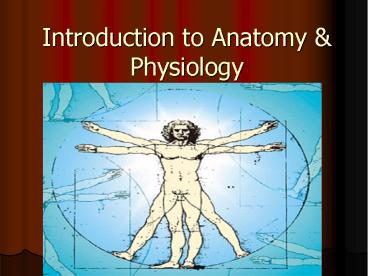Introduction to Anatomy - PowerPoint PPT Presentation
Title:
Introduction to Anatomy
Description:
Introduction to Anatomy & Physiology – PowerPoint PPT presentation
Number of Views:218
Avg rating:3.0/5.0
Title: Introduction to Anatomy
1
Introduction to Anatomy Physiology
2
Standard IHS 7
- Introduction to Life Changes The Process of
Change - HS-IHS-7 The student will compare and contrast
the life changes from - conception throughout the lifespan as it relates
to all growth and developmental needs. - Investigate the interdependence of the various
body systems to each other and to the body as a
whole. - Explain the role of homeostasis and its
mechanisms as these relate to the body as a whole
and predict the consequences of the failure to
maintain homeostasis. - Describe how structure and function are related
in terms of cell and tissue types. - Describe the stages of growth and development
from conception throughout the lifespan including
correlations to Maslows Hierarchy of Needs. - Examine various conditions that change normal
body functions i.e. tissue rejection,
allergies, injury, diseases and disorders - and
how the body responds. - Describe effects of aging on all body systems.
3
OBJECTIVE
- INVESTIGATE THE INTERDEPENDENCE OF BODY SYSTEMS
TO EACH OTHER TO THE BODY AS A WHOLE
4
How Well
- Mastery on all assessments,
- Completion of all Labs
- Completion of worksheet packets for all units
5
ANATOMY
- THE STUDY OF THE FORM STRUCTURE OF THE
HUMAN BODY - Where is the heart?
- How large is the liver?
- How many muscles do you have?
6
PHYSIOLOGY
- Study of how a living organism works.
- How does the heart know when to beat?
- What makes a muscle stretch?
- How does the liver store CHO?
7
PROTOPLASM
- Basic substance of all LIFE
- ordinary elements such as
- C
- O2
- H
- S
- N
- P
8
CELLS
- Protoplasm comes together to form cells
- CELLS are the basic unit of structure function
of all living things. - Microscopic
- Carry on all functions of life
9
- Require O2
- Produce heat energy
- Move adapt to environment
- Eliminate waste products
- Perform special functions
10
CELL PARTS
- Cell membrane- outer protective covering Allows
substances to enter leave cell - Cytoplasm semi- fluid substance inside of cell.
Contains water, fats, proteins, CHO, minerals,
salts.
11
- ORGANELLS- Structures inside the cell
- Nucleus- The brain, main controls
- Nucleolus- RNA production inside the nucleus
- Chromatin- Inside the nucleus, makes DNA
chromosomes - Mitochondria- rod shaped, powerhouse of the cell,
makes energy - Golgi Apparatus- Produces, stores packages
secretions for discharge form the cell. Garbage
Compactor of the cell
12
- Endoplasmic Recticulum- tubular structures that
allows for transportation of materials into out
of the cell. Train of the cell - smooth- makes cholesterol, detox
- from drugs
- Rough- builds proteins
- Lysosomes- oval bodies that digest destroy old
cells. Pac Man of the cell - Pinocytic Vesicles- folds in cell membrane. The
folds capture hold protein fats, then form
bubbles to help then enter the cell
13
Reproduction
- Cells need to reproduce to keep organism
alive - Skin, blood forming cells, intestinal tract
cells reproduce continuously - Muscle cells reproduce every few years, but most
can be enlarged by exercising - Special cells such as nerve cells in the brain
spinal cord do not reproduce after birth, if
they are damaged they cannot be repaired or
replaced
14
MITOSIS VS MEIOSIS
- Mitosis is the process of cell division of a
normal cell. Has 46 chromosomes - Meiosis is the cell division of a sex cell (sperm
ovum) which halves the number of chromosomes.
Each sex cell has 23 chromosomes.
15
Tissues
- Cells of the same type that are joined together
for a common purpose
16
4 TYPES OF TISSUE
- EPITHELIAL
- CONNECTIVE
- NERVE
- MUSCLE
17
EPITHELIAL
- COVERS THE BODY , MAIN TISSUE OF THE SKIN
- FORMS LINING OF THE INTESTINAL, RESPIRATORY,
CIRCULATORY URINARY TRACT - FORMS GLANDS OF THE BODY
18
CONNECTIVE
- SUPPORTIVE FABRIC OF THE BODY
- 3 TYPES
- SOFT- Adipose or fat (insulates body)
- Tendons, ligaments
- HARD- Cartilage bone
- LIQUID- Blood
19
(No Transcript)
20
NERVE
- Made of neurons
- Carries nerve messages from brain throughout the
body
21
MUSCLE
- Produces power movement of the body
- 3 Types
- Skeletal- attaches to bone to move body
- Cardiac- cause heart to beat
- Smooth present in the walls of blood vessels,
walls of respiratory, urinary digestive tracks
22
Organs
- TISSUES JOINED TOGETHER TO PERFORM A COMMON
FUNCTION - Heart, lungs, stomach, brain, skin, pancreas,
uterus etc
23
SYSTEM
- Organs joined together for a common purpose
- Digestive System
- Respiratory System
- Urinary System
- Reproductive System
24
Organism
- Systems joined together for a common good
- THE HUMAN ORGANISM































